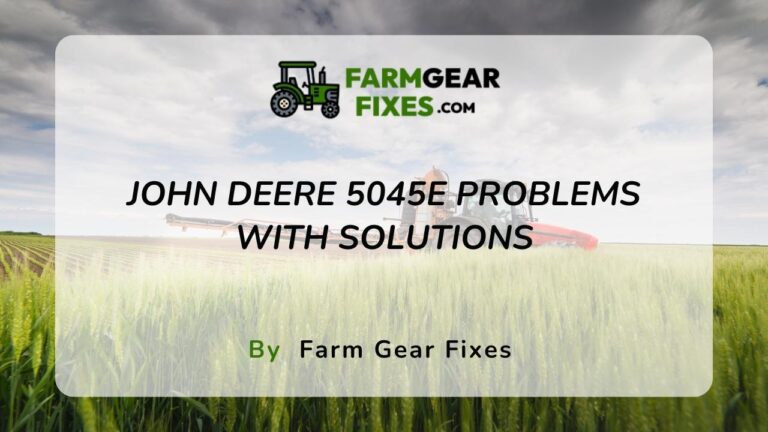7 Common John Deere 333G Problems (Solutions Included)

Having trouble with your John Deere 333G? Don’t worry! We’ve put together a simple list of common problems people face with this construction machine and easy solutions for each one.
Whether it’s hydraulic system malfunctions, engine troubles, or electrical glitches, we’ve got you covered with expert advice and insider tips to keep your 333G running smoothly and efficiently. Say goodbye to downtime and frustrating setbacks, and hello to a more reliable and productive workhorse with our tried-and-tested solutions.
John Deere 333g Issues and Their Solutions
Engine and Powertrain Issues
Before we delve into the common problems with the John Deere 333G, it’s important to understand the engine and powertrain issues that may arise. These issues can range from startup problems to overheating engines and power loss concerns.
We will discuss the troubleshooting and solutions for these issues to help you keep your John Deere 333G running smoothly.
1) Troubleshooting Startup Problems
Troubleshooting startup problems with the John Deere 333G can be a frustrating experience. Common issues include difficulty starting the engine, rough idling, or stalling after startup.
To address these problems, it is important to inspect the fuel system, check for any clogged filters, and ensure that the battery and electrical system are functioning properly. Additionally, checking for any error codes or diagnostic alerts can provide valuable information for troubleshooting these startup issues.
One of the potential solutions for addressing overheating engines in the John Deere 333G is to inspect the cooling system for any leaks, blockages, or damaged components.
Regular maintenance of the cooling system, including flushing and replacing the coolant as recommended by the manufacturer, can also help prevent overheating issues. It is important to address any overheating concerns promptly to avoid potential damage to the engine and ensure optimal performance of the machine.
This subsection provides helpful insights on how to address overheating engines in the John Deere 333G, a common issue that can affect the machine’s performance and longevity. By understanding the potential causes of overheating and implementing the suggested solutions, operators can effectively manage and prevent overheating concerns.
2) Addressing Power Loss Concerns
Overheating engines in the John Deere 333G can lead to power loss concerns, affecting the machine’s productivity and efficiency. It is important to address any overheating issues promptly and thoroughly inspect the engine and powertrain components to identify the underlying cause of the power loss.
Common contributors to power loss may include a malfunctioning turbocharger, fuel system issues, or exhaust restrictions, among others.
With regular maintenance and attentive monitoring of the engine and powertrain, operators can effectively address and prevent power loss concerns in the John Deere 333G.
By adhering to the manufacturer’s recommended maintenance schedule and promptly addressing any warning signs of power loss, operators can optimize the performance and reliability of their machines.
Hydraulic System Challenges
Any heavy machinery comes with its own set of challenges, and the John Deere 333G is no exception. One of the key areas that operators often encounter problems with is the hydraulic system. Understanding the common issues that can arise, as well as how to effectively address them, is crucial for maintaining the optimal performance of the 333G.
3) Identifying Hydraulic Leaks and Fixes
On a construction site, the last thing you want to deal with is a hydraulic leak. Not only can it result in a loss of fluid, but it can also lead to a drop in system efficiency. Regularly inspecting the hydraulic system for any signs of leaks, such as puddles or damp spots, is important.
Additionally, keeping an eye out for worn-out seals, loose connections, or damaged hoses can help prevent potential leaks. Should a leak be detected, it is essential to address it promptly by replacing any faulty components, tightening connections, or conducting necessary repairs to avoid any further damage to the hydraulic system.
4) Optimizing Hydraulic Pressure and Flow
On the John Deere 333G, maintaining the correct hydraulic pressure and flow is vital for maximizing efficiency and performance. Regularly monitoring the pressure levels and flow rate can help identify any issues before they escalate.
Adjusting the relief valve and ensuring the hydraulic pump is functioning at the appropriate capacity can help optimize pressure and flow. Additionally, installing and maintaining proper filters can prevent contamination and blockages, which can impede the flow of hydraulic fluid.
Plus, incorporating the use of quality hydraulic fluid and periodically conducting fluid analysis can aid in identifying potential issues and maintaining the overall health of the hydraulic system.
Preventive Maintenance for Hydraulics
Flowing seamlessly through the hydraulic system, the hydraulic fluid is like the lifeblood of the John Deere 333G. Regularly scheduled maintenance, including fluid level checks, filter replacements, and system inspections, is crucial for preventing any potential issues from arising.
Adhering to the manufacturer’s recommended maintenance schedule and guidelines can help ensure the hydraulic system functions optimally, minimizing the risk of unexpected downtime or costly repairs.
Leaks, contamination, and pressure discrepancies are common issues that can arise in hydraulic systems. Incorporating preventive measures such as regular inspections, seal replacements, and fluid analysis can help mitigate these risks, ultimately extending the longevity of the system and optimizing the 333G’s performance.
Electronic and Software Glitches
Keep your John Deere 333G running smoothly by being aware of potential electronic and software glitches. These issues can cause significant downtime and frustration, but with the right knowledge and solutions, you can minimize their impact on your operations.
5) Resolving Control System Errors
System malfunctions and control system errors can be disruptive to your workflow. It’s important to regularly check for error codes and address any issues promptly.
Consult the user manual or contact a qualified technician to diagnose and resolve these errors. Regular maintenance and calibration of the control system can also help prevent these errors from occurring.
6) Software Update Procedures
Errors in the software can lead to performance issues and compatibility problems. To ensure optimal performance, it’s crucial to stay up to date with software updates for your John Deere 333G.
Refer to the manufacturer’s guidelines for proper update procedures, and make sure to back up your data before proceeding with any updates. Keeping the software current can enhance the machine’s functionality and resolve known bugs and glitches.
To maintain the reliability and efficiency of your John Deere 333G, it’s essential to stay proactive in addressing electronic and software glitches. Regular monitoring, timely resolutions, and adherence to updated procedures can help you mitigate potential issues and keep your machine operating at its best.
Undercarriage and Attachments
For heavy-duty equipment like the John Deere 333G, the undercarriage and attachments play a crucial role in ensuring the overall performance and efficiency of the machine. Proper maintenance and troubleshooting of the undercarriage and attachments are essential to avoid any potential problems and to ensure optimal functionality.
6) Maintaining Track Tension and Integrity
With the constant wear and tear of the machine’s undercarriage, it is important to regularly inspect and adjust the track tension to ensure proper alignment and prevent premature wear of the tracks. Additionally, maintaining the integrity of the tracks by cleaning out debris and checking for any visible signs of damage is essential for the overall longevity of the undercarriage.
7) Troubleshooting Attachment Connectivity
The connectivity of attachments to the John Deere 333G is vital for its productivity. The hydraulic connections, electrical connections, and mechanical linkages must be regularly inspected for any signs of wear, damage, or malfunction.
The seamless connectivity of attachments is crucial for the machine to perform at its best and any issues should be addressed immediately to avoid costly downtime.
Maintaining a regular maintenance schedule for the undercarriage and attachments, including track tension adjustments and thorough inspections of attachment connectivity, is key to maximizing the lifespan and performance of the John Deere 333G. By staying proactive in troubleshooting these areas, potential problems can be mitigated and the overall productivity of the machine can be optimized.
Conclusion
The issues faced by John Deere 333G owners can be frustrating and costly, but there are solutions to many of these problems. Whether it’s hydraulic issues, electrical malfunctions, or engine troubles, it’s essential to address these problems promptly and efficiently.
By conducting regular checks, properly maintaining the equipment, and seeking professional help when needed, many of these problems can be resolved. It’s important to be proactive in addressing any potential issues and staying up to date on the latest maintenance practices to keep your John Deere 333G running smoothly for years to come.






